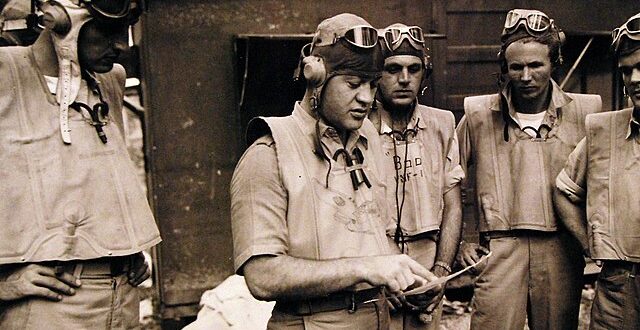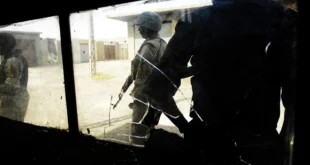by Katie Lange
Editor’s note: SOF publisher Susan Katz Keating knew Col. Pappy Boyington in the 1980’s when he frequented the Nut Tree airport in Vacaville, California. Here is a story of his life in uniform.
Colonel Gregory “Pappy” Boyington was one of the service’s greatest and most legendary pilots. His exploits as a World War II aviator became so famous that they were made into a TV show. But behind the scenes, his leadership vastly helped the Allies in the Pacific, and it was that persistence that earned him the Medal of Honor.
Boyington was born Dec. 4, 1912, in Coeur D’Alene, Idaho. His parents divorced when he was very young, so he grew up with his mother and stepfather, Gregory Hallenbeck, who raised him with the Hallenbeck surname.
Boyington’s interest in flying began early in life. He built model airplanes as a boy and even talked famed stunt pilot Clyde Pangborn into taking him and a friend for a ride when Pangborn was performing at a nearby flying exhibition.
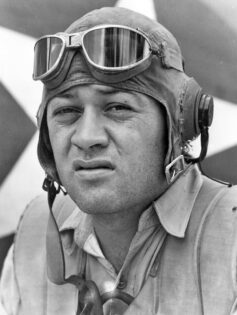
The Hallenbecks moved Boyington and his half-brother, William, to an apple farm in Tacoma, Washington, when he was 12. After high school, the teen went to the University of Washington, where he swam, wrestled and took part in ROTC all four years.
READ MORE: Spotlight: Commemorating World War II
Boyington graduated with a degree in aeronautical engineering in 1934 before commissioning into the Army Coast Artillery Reserve. At some point, he married his college sweetheart, Helen Clark. The two had three children, Gregory Jr., Janet and Gloria. He also began working as an engineer for Boeing Aircraft Company in Seattle.
About a year later, Boyington enlisted in the Volunteer Marine Corps Reserve. It was then that he realized he wasn’t actually a Hallenbeck. According to his mother, Boyington had always assumed Gregory Hallenbeck was his biological father — they had never told him otherwise. But he needed his birth certificate to join the Marines, and that’s when he discovered his real father was Charles Boyington. He also learned that he couldn’t become an aviation cadet if he was married, so he decided to enlist under the name Boyington — a name that had no record of his marriage.
A Storied Career Begins
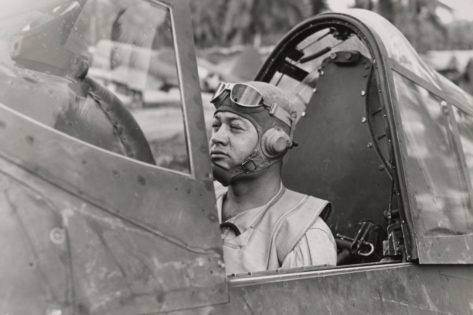
sits in an aircraft somewhere in the South Pacific, May 1, 1943.
Boyington was eventually appointed as a Marine aviation cadet, officially earning his pilot’s wings on March 11, 1937. He served in Quantico, Virginia, before commissioning into the regular Marine Corps in July 1937.
Four years later, he resigned that commission to accept a position with the Central Aircraft Manufacturing Company, a civilian organization. CAMCO became the American Volunteer Group — better known as the Flying Tigers — a unit of American military aviators sent to aid China in its fight against Japan, which was trying to expand its empire across the Pacific.
READ MORE about pilots in World War II
The Flying Tigers deployed to Burma in the summer of 1941. By the time the U.S. had joined World War II after the Pearl Harbor attacks, Boyington was serving as a squadron commander and had been unofficially credited with shooting down several Japanese aircraft over China.
Boyington returned to the U.S. in July 1942 when the Flying Tigers disbanded. He was commissioned back into the military in September 1942, this time as an active-duty first lieutenant in the Marine Corps Reserve. He was promoted to major a month later.
Boyington was sent back to the Pacific and served as the executive officer of Marine Fighting Squadron 121 during the spring of 1943, after the Guadalcanal campaign had finished. It’s when he earned his nickname “Pappy,” because at 31, he was nearly a decade older than most of the men serving under him.
In the fall of 1943, Boyington took over command of the newly formed Marine Fighting Squadron 214. Dubbed the “Black Sheep Squadron,” the unit flew F-4U Corsair fighters during their campaign to seize bases in the Central Solomon Islands. Their main goal: to isolate an enemy stronghold at Rabaul, New Britain.
Leading the Pack
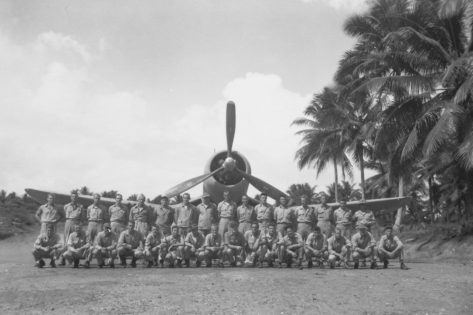
Espiritu Santo, New Hebrides, with an F-4U Corsair in the background, sometime in 1943.
Between Sept. 12, 1943, and Jan. 3, 1944, Boyington led his pilots on several daring flights over heavily defended enemy territory that crippled Japanese shipping, shore installations and aerial forces.
On Oct. 17, the major led a formation of 24 fighters over Kahili Airfield on the island of Bougainville. They circled the airfield, challenging the Japanese to send up any of the 60 aircraft that were grounded there. In the ensuing action, 20 Japanese aircraft were shot down, while not a single Marine aircraft was lost.
During his three months in charge of VMF 214, Boyington destroyed more than two dozen Japanese aircraft. His leadership helped develop combat readiness within his command, which was credited with being a distinctive factor in the Allies’ aerial achievements over that area of the Pacific.
Unfortunately, Boyington was shot down over Rabaul on Jan. 3, 1944. He was picked up by a Japanese submarine and spent 20 months as a prisoner of war – something American officials weren’t made aware of until the war ended. Boyington, who was promoted to lieutenant colonel during captivity, was released from a POW camp in Tokyo on Aug. 29, 1945.
When Boyington returned to the U.S., his last two “kills” on the day he disappeared over Rabaul were quickly confirmed. That brought the total number of Japanese aircraft he’d shot down to 28 — the highest tally for any Marine ace during the war, according to the Marine Corps University.
On Oct. 5, 1945, Boyington joined several other Marines at a ceremony at the White House to receive the Medal of Honor from President Harry S. Truman. The high honor was bestowed upon him posthumously by President Franklin D. Roosevelt in March 1944 — but now that he was alive, he was able to receive it in person.
After going on a Victory Bond Tour, Boyington continued his Marine Corps career, first back at Quantico, then at Marine Corps Air Depot in San Diego. He retired on Aug. 1, 1947, and was advanced to his final rank of colonel.
Boyington and his first wife, Helen, divorced when he was deployed to China. He married three more times, finally settling down with Josephine Wilson in 1975, according to a 1992 article in The Fresno Bee.
On Jan. 11, 1988, a 75-year-old Boyington died of cancer at a hospice in Fresno, California. He was interred in Arlington National Cemetery with full military honors.
Boyington’s aviation exploits were the stuff of legend. In the last few decades of his life, he wrote an autobiography titled “Baa Baa Black Sheep.” It became a national best-seller and was turned into a TV show in the 1970s called “Black Sheep Squadron.”
In 1994, the Marine commander was enshrined in the Naval Aviation Hall of Honor at the National Museum of Naval Aviation. The airport in Coeur D’Alene, Idaho, Boyington’s hometown, was renamed the Pappy Boyington Field in 2007.
Boyington’s wife donated his Medal of Honor to the Marines Memorial Association’s Marines Memorial Club in San Francisco, where it remains on display in the club’s restaurant.
 Soldier of Fortune Magazine The Journal of Professional Adventurers
Soldier of Fortune Magazine The Journal of Professional Adventurers


